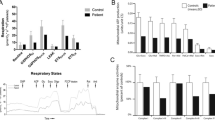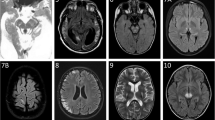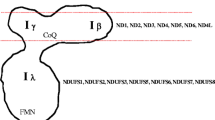Abstract
Defects of the mitochondrial oxidative phosphorylation (OXPHOS) system are frequent causes of neurological disorders in children. Linkage analysis and DNA sequencing identified a new founder p.G250V substitution in the C20ORF7 complex I chaperone in five Ashkenazi Jewish patients from two families with a combined OXPHOS complex I and IV defect presenting with Leigh's syndrome in infancy. Complementation with the wild type gene restored complex I, but only partially complex IV activity. Although the pathogenic mechanism remains elusive, a C20ORF7 defect should be considered not only in isolated complex I deficiency, but also in combination with decreased complex IV. Given the significant 1:290 carrier rate for the p.G250V mutation among Ashkenazi Jews, this mutation should be screened in all Ashkenazi patients with Leigh's syndrome prior to muscle biopsy.


Similar content being viewed by others
References
Barghuti F, Elian K, Gomori JM et al. (2008) The unique neuroradiology of complex I deficiency due to NDUFA12L defect. Mol Genet Metab 94:78–82
Calvo SE, Tucker EJ, Compton AG et al. (2010) High-throughput, pooled sequencing identifies mutations in NUBPL and FOXRED1 in human complex I deficiency. Nat Genet 42:851–858
Carroll J, Fearnley IM, Skehel JM et al. (2005) The post-translational modifications of the nuclear encoded subunits of complex I from bovine heart mitochondria. Mol Cell Proteomics 4:693–699
Carroll J, Fearnley IM, Skehel JM, Shannon RJ, Hirst J, Walker JE (2006) Bovine complex I is a complex of 45 different subunits. J Biol Chem 281:32724–132727
DiMauro S, Schon EA (1998) Nuclear power and mitochondrial disease. Nat Genet 19:214–215
Dunning CJ, McKenzie M, Sugiana C (2007) Human CIA30 is involved in the early assembly of mitochondrial complex I and mutations in its gene cause disease. EMBO J 26:3227–3237
Edvardson S, Shaag A, Kolesnikova O et al. (2007) Deleterious mutation in the mitochondrial arginyl-transfer RNA synthetase gene is associated with pontocerebellar hypoplasia. Am J Hum Genet 81:857–862
Fassone E, Duncan AJ, Taanman JW, Pagnamenta AT, Sadowski MI, Holand T, Qasim W, Rutland P, Calvo SE, Mootha VK, Bitner-Glindzicz M, Rahman S (2010) FOXRED1, encoding an FAD-dependent oxidoreductase complex-I-specific molecular chaperone, is mutated in infantile-onset mitochondrial encephalopathy. Hum Mol Genet 19:4837–4847
Gerards M, Sluiter W, van den Bosch BJ et al. (2010) Defective complex I assembly due to C20orf7 mutations as a new cause of Leigh syndrome. J Med Genet 47:507–551
Gerards M, van den Bosch BJ, Danhauser K, Serre V, van Weeghel M, Wanders RJ, Nicolaes GA, Sluiter W, Schoonderwoerd K, Scholte HR, Prokisch H, Rötig A, de Coo IF, Smeets HJ (2011) Riboflavin-responsive oxidative phosphorylation complex I deficiency caused by defective ACAD9: new function for an old gene. Brain 134:210–209
Haack TB, Danhauser K, Haberberger B et al. (2010) Exome sequencing identifies ACAD9 mutations as a cause of complex I deficiency. Nat Genet 42:1131–1134
Janssen RJ, Nijtmans LG, van den Heuvel LP, Smeitink JA (2006) Mitochondrial complex I: structure, function and pathology. J Inherit Metab Dis 29:499–51
Jones CN, Miller C, Tenenbaum A, Spremulli LL, Saada A (2009) Antibiotic effects on mitochondrial translation and in patients with mitochondrial translational defects. Mitochondrion 9:429–437
Kirby DM, Crawford M, Cleary MA, Dahl HH, Dennett X, Thorburn DR (1999) Respiratory chain complex I deficiency: an underdiagnosed energy generation isorder. Neurology 52:1255–1264
Lazarou M, Thorburn DR, Ryan MT, McKenzie M (2009) Assembly of mitochondrial complex I and defects in disease. Biochim Biophys Acta 1793:78–88
Mckenzie M, Ryan MT (2010) Assembly factors of human mitochondrial complex I and their defects in disease. IUBMB Life 62:497–502
Nouws J, Nijtmans L, Houten SM et al. (2010) Acyl-CoA dehydrogenase 9 is required for the biogenesis of oxidative phosphorylation complex I. Cell Metab 12:283–294
Ogilvie I, Kennaway NG, Shoubridge EA (2005) A molecular chaperone for mitochondrial complex I assembly is mutated in a progressive encephalopathy. J Clin Invest 115:2784–2792
Pagliarini DJ, Calvo SE, Chang B et al. (2008) A mitochondrial protein compendium elucidates complex I disease biology. Cell 134:112–12324
Pogozelski WK, Hamel CJ, Woeller CF et al. (2003) Quantification of total mitochondrial DNA and the 4977-bp common deletion in Pearson's syndrome lymphoblasts using a fluorogenic 5'-nuclease (TaqMan) real-time polymerase chain reaction assay and plasmid external calibration standards. Mitochondrion 2:415–427
Saada A, Bar-Meir M, Belaiche C, Miller C, Elpeleg O (2004) Evaluation of enzymatic assays and compounds affecting ATP production in mitochondrial respiratory chain complex I deficiency. Anal Biochem 335:66–72
Saada A, Edvardson S, Rapoport M et al. (2008) C6ORF66 is an assembly factor of mitochondrial complex I. Am J Hum Genet 82:32–38
Saada A, Vogel RO, Hoefs SJ et al. (2009) Mutations in NDUFAF3 (C3ORF60), encoding an NDUFAF4 (C6ORF66)-interacting complex I assembly protein, cause fatal neonatal mitochondrial disease. Am J Hum Genet 84:718–727
Schaefer AM, McFarland R, Blakely EL et al. (2008) Prevalence of mitochondrial DNA disease in adults. Ann Neurol 63:35–39
Sheftel AD, Stehling O, Pierik AJ et al. (2009) Human ind1, an iron-sulfur cluster assembly factor for respiratory complex I. Mol Cell Biol 29:6059–6073
Skladal D, Halliday J, Thorburn DR (2003) Minimum birth prevalence of mitochondrial respiratory chain disorders in children. Brain 126:1905–1912
Sugiana C, Pagliarini DJ, McKenzie M et al. (2008) Mutation of C20orf7 disrupts complex I assembly and causes lethal neonatal mitochondrial disease. Am J Hum Genet 83:468–478
Vince JE, Wong WW, Khan N et al. (2007) IAP antagonists target cIAP1 to induce TNFalpha-dependent apoptosis. Cell 131:682–693
Acknowledgements
The authors are most grateful to Prof. Thorburn and Dr. Alison Compton for supplying the viral vector. Dr. Phyllis Dan and Mrs. Sarah Weissman are acknowledged for technical assistance. Rabbi Shlomo Bochner is acknowledged for support. This work was also supported by the Israeli Ministry of Health, grant# 5914 ( A.S. and O.E.) and by the Israeli Academy of Sciences, grant, # 1462/09 (A.S.)
Author information
Authors and Affiliations
Corresponding author
Additional information
Communicated by: Shamima Rahman
Competing interest: None declared.
Electronic supplementary material
Supplementary data
Homozygous regions and genes, located in these regions from families I and II (DOC 28 kb)
Rights and permissions
About this article
Cite this article
Saada, A., Edvardson, S., Shaag, A. et al. Combined OXPHOS complex I and IV defect, due to mutated complex I assembly factor C20ORF7. J Inherit Metab Dis 35, 125–131 (2012). https://doi.org/10.1007/s10545-011-9348-y
Received:
Revised:
Accepted:
Published:
Issue Date:
DOI: https://doi.org/10.1007/s10545-011-9348-y




